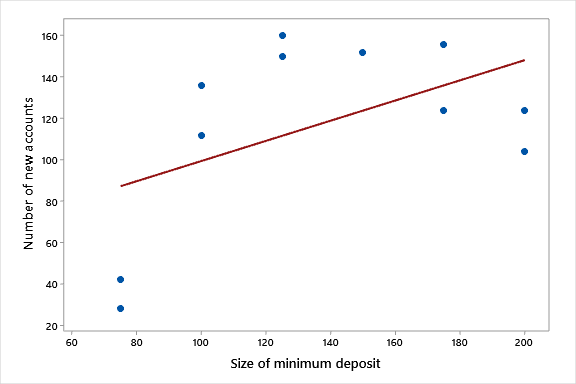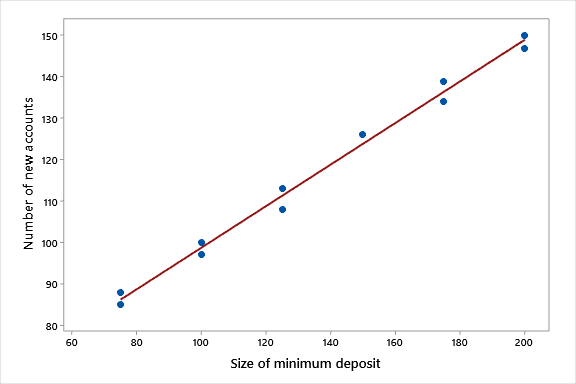Example 2-3 Section
If you think about it, there are two different explanations for why our data points might not fall right on the estimated regression line. One possibility is that our regression model doesn't describe the trend in the data well enough. That is, the model may exhibit a "lack of fit." The second possibility is that, as is often the case, there is just random variation in the data. This realization suggests that we should decompose the error into two components — one part due to the lack of fit of the model and the second part just due to random error. If most of the error is due to lack of fit, and not just random error, it suggests that we should scrap our model and try a different one.
Let's try decomposing the error in the checking account example, (New Accounts data). Recall that the prediction error for any data point is the distance of the observed response from the predicted response, i.e., \(y_{ij}-\hat{y}_{ij}\). (Can you identify these distances on the plot of the data below?) To quantify the total error of prediction, we determine this distance for each data point, square the distance, and add up all of the distances to get:
\(\sum_{i}\sum_{j}(y_{ij}-\hat{y}_{ij})^2\)
Not surprisingly, this quantity is called the "error sum of squares" and is denoted SSE. The error sum of squares for our checking account example is \(\sum_{i}\sum_{j}(y_{ij}-\hat{y}_{ij})^2=14742\).
If a line fits the data well, then the average of the observed responses at each x-value should be close to the predicted response for that x-value. Therefore, to determine how much of the total error is due to the lack of model fit, we determine how far the average observed response at each x-value is from the predicted response of each data point. That is, we calculate the distance \(\bar{y}_{i}-\hat{y}_{ij}\). To quantify the total lack of fit, we determine this distance for each data point, square the distance, and add up all of the distances to get:
\(\sum_{i}\sum_{j}(\bar{y}_{i}-\hat{y}_{ij})^2\)
Not surprisingly, this quantity is called the "lack of fit sum of squares" and is denoted SSLF. The lack of fit sum of squares for our checking account example is \(\sum_{i}\sum_{j}(\bar{y}_{i}-\hat{y}_{ij})^2=13594\).
To determine how much of the total error is due to just random error, we determine how far each observed response is from the average observed response at each x-value. That is, we calculate the distance \(y_{ij}-\bar{y}_{i}\). To quantify the total pure error, we determine this distance for each data point, square the distance, and add up all of the distances to get:
\(\sum_{i}\sum_{j}(y_{ij}-\bar{y}_{i})^2\)
Not surprisingly, this quantity is called the "pure error sum of squares" and is denoted SSPE. The pure error sum of squares for our checking account example is \(\sum_{i}\sum_{j}(y_{ij}-\bar{y}_{i})^2=1148\).

\(\hat{y}=50.7+.49x\)
\(\sum_{i}\sum_{j}(y_{ij}-\hat{y}_{ij})^2=14742\)
\(\sum_{i}\sum_{j}(\bar{y}_{i}-\hat{y}_{ij})^2=13594\)
\(\sum_{i}\sum_{j}(y_{ij}-\bar{y}_{i})^2=1148\)
In summary, we've shown in this checking account example that most of the error (SSE = 14742) is attributed to the lack of a linear fit (SSLF = 13594) and not just to random error (SSPE = 1148).
Example 2-4 Section
Let's see how our decomposition of the error works with a different example — one in which a line fits the data well. Suppose the relationship between the size of the minimum deposit required when opening a new checking account at a bank (x) and the number of new accounts at the bank (y) instead looks like this:

\(\hat{y}=48.7+0.50x\)
\(\sum_{i}\sum_{j}(y_{ij}-\hat{y}_{ij})^2=45.1\)
\(\sum_{i}\sum_{j}(\bar{y}_{i}-\hat{y}_{ij})^2=6.6\)
\(\sum_{i}\sum_{j}(y_{ij}-\bar{y}_{i})^2=38.5\)
In this case, as we would expect based on the plot, very little of the total error (SSE = 45.1) is due to a lack of a linear fit (SSLF = 6.6). Most of the error appears to be due to just random variation in the number of checking accounts (SSPE = 38.5).
In summary Section
The basic idea behind decomposing the total error is:
- We break down the residual error ("error sum of squares" — denoted SSE) into two components:
- a component that is due to a lack of model fit ("lack of fit sum of squares" — denoted SSLF)
- a component that is due to pure random error ("pure error sum of squares" — denoted SSPE)
- If the lack of fit sum of squares is a large component of the residual error, it suggests that a linear function is inadequate.
Here is a simple picture illustrating how the distance \(y_{ij}-\hat{y}_{ij}\) is decomposed into the sum of two distances \(\bar{y}_{i}-\hat{y}_{ij}\) and \(y_{ij}-\bar{y}_{i}\). Drag the bar at the bottom of the image to see each of the three components of the equation represented geometrically.
Although the derivation isn't as simple as it seems, the decomposition holds for the sum of the squared distances as well:
\(\underbrace{\sum\limits_{i=1}^c \sum\limits_{j=1}^{n_i} \left(y_{ij} - \hat{y}_{ij}\right)^{2}}_{\underset{\text{Error Sum of Squares}}{\text{SSE}}} = \underbrace{\sum\limits_{i=1}^c \sum\limits_{j=1}^{n_i} \left(\overline{y}_{i} - \hat{y}_{ij}\right)^{2}}_{\underset{\text{Lack of Fit Sums of Squares}}{\text{SSLF}}} + \underbrace{\sum\limits_{i=1}^c \sum\limits_{j=1}^{n_i} \left(y_{ij} - \overline{y}_{i}\right)^{2}}_{\underset{\text{Pure Error Sum of Squares}}{\text{SSPE}}}\)
SSE = SSLF + SSPE
The degrees of freedom associated with each of these sums of squares follow a similar decomposition.
- As before, the degrees of freedom associated with SSE is n-2. (The 2 comes from the fact that you estimate 2 parameters — the slope and the intercept — whenever you fit a line to a set of data.)
- The degrees of freedom associated with SSLF is c-2, where c denotes the number of distinct x values you have.
- The degrees of freedom associated with SSPE is n-c, where again c denotes the number of distinct x values you have.
You might notice that the degrees of freedom breakdown as:
\(\underset{\substack{\text{degrees of freedom}\\ \text{associated with SSE}}}{\left(n-2\right)} = \underset{\substack{\text{degrees of freedom}\\ \text{associated with SSLF}}}{\left(c-2\right)} + \underset{\substack{\text{degrees of freedom}\\ \text{associated with SSPE}}}{\left(n-c\right)}\)
where again c denotes the number of distinct x values you have.